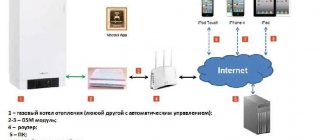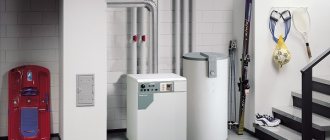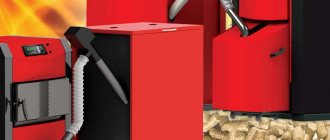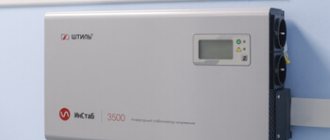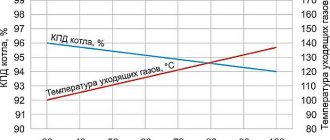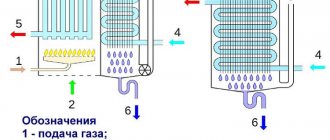Choosing a gas boiler for a heating system is a responsible task.
The continuity of the heating process depends on the efficiency and reliability of its design, which is very important in the cold season.
Incorrect selection of unit parameters can cause the temperature in the house to be insufficiently high, or cause abnormal operation of the boiler.
In addition, it is necessary to select a unit design that matches the needs and capabilities of the home.
Condensing boilers appeared relatively recently, so we need to talk about them in more detail.
What is a condensing gas boiler?
The usual design of gas boilers involves single-stage heating of the coolant. It enters the primary heat exchanger and receives the temperature set by the operating mode. A condensing gas boiler is more complex.
Heating of the coolant in it occurs in two stages:
- primary preparation of liquid in the condensation chamber;
- final heating in the primary heat exchanger (in the usual way).
Thermal energy for heating the first stage arises from the condensation of water vapor from their smoke and exhaust combustion products. The point of the procedure is that this heat usually disappears .
If the coolant is warmed up even a little, the load on the main heat exchanger will drop. There is a positive dynamics in the operating mode, which makes it possible to reduce gas consumption, reduce wear on the main components of the boiler and obtain an increased effect from its operation.
Fuel savings are about 20%, but prices for condensing models are almost twice as high as those for convection designs.
According to manufacturers, the efficiency of such devices is 107-109%, which is impossible from the standpoint of physics. This is a very clumsy marketing ploy, since it is incorrect to rely on an illiterate buyer from manufacturers of heating equipment.
They simply added the efficiency of the condensing chamber to the efficiency level of the base model on which the design was based.
NOTE!
For full operation of the unit, a specific operating mode is required. It is capable of demonstrating positive results only on low-temperature heating systems such as underfloor heating, and with radiator circuits it most often functions as a regular convection unit.
Organizing the connection of the boiler to an indirect heating boiler
Before you buy a condensing single-circuit gas boiler in Moscow for a private home, you need to worry in advance about the possibility of heating sanitary water. As a rule, this will require additional installation of an indirect heating boiler, which can be implemented in the following ways:
- if there is an inlet-outlet and a built-in three-way valve under the boiler, it is enough to simply install the latter in accordance with the manufacturer’s instructions;
- if there is no corresponding fitting, then external three-way valves are installed, connected to the boiler automation. Further, the boiler connection diagram is similar if the fitting for the boiler was provided in the basic configuration;
- in more complex heating and hot water supply systems, a pump group is used to ensure the supply of coolant and heated sanitary water to remote corners of a private house.
Regardless of the chosen connection scheme, condensing single-circuit boilers operate on the principle of 100% priority in relation to the indirect heating boiler. Thus, when a signal is received from the boiler temperature sensor, the boiler automation stops performing the current task and switches to the mode of heating water in the boiler. After reaching the set temperature in the boiler, the boiler switches to the previously programmed operating mode.
Despite the fact that the price of a single-circuit condensing boiler increases significantly when a boiler is connected, it fully pays for itself when implemented in a large private house where there are more than 3 water intake points.
Advantages and disadvantages
The advantages of condensing boilers include:
- high performance heating system;
- fuel savings reaches 20%;
- the load on all main components of the boiler is reduced, which increases the service life of the unit;
- in the absence of the necessary conditions, the work does not stop, the boiler functions as a conventional convection-type device.
The disadvantages of such designs are:
- for work it is necessary to create specific conditions, which is not always possible;
- To dispose of condensate, it is necessary to take special measures - it contains a large amount of acid, so it is prohibited to drain it into the sewer;
- the cost of condensing units is much higher, and repairs will be more expensive than traditional models.
The disadvantages are few, but they are quite significant. For normal operation of a condensing boiler with a radiator system, it is necessary that the difference in temperature outside and indoors does not exceed 20°.
Otherwise, there will be no conditions for condensation of water vapor. But the use of heated floors is not always possible and advisable. These features significantly limit the demand for such designs .
Perhaps this is where the attempt of manufacturers to intensify sales begins, indicating obviously impossible efficiency.
Heating system requirements
Before installing heating equipment from scratch, you must have a complete package of documents on hand, including a plan with a distribution system, as well as relevant engineering calculations.
If you already had, say, a single-circuit boiler, then it will be practically easy to replace it with the same condenser version, only double-circuit.
A situation may arise that you want to completely replace the heating system, from conventional to condensing. This, of course, will require additional material investments. The main costs will be borne by the condenser itself. However, installation and installation will no longer be so expensive.
When changing the heating system to the option under consideration, it may be necessary to replace the chimney. After all, the specificity of the exhaust gases of this boiler is such that they must be discharged through pipes made of a certain material of manufacture.
In order to avoid unnecessary expenses, you can modernize the existing version of the chimney by using a single-wall stainless steel pipe liner, as well as a plastic pipe outlet.
Read more: “Checking gas equipment”
Condensation Formation
It is noted that when a condensing device with a power of 24 kW is operating, switched on to low-temperature mode, with a load of 50%, it produces about 40 liters of condensate per day.
It is not allowed to dispose of acid from condensate directly into the soil, as a “dead spot” may form. Low concentration condensate can be drained into the sewer, diluting approximately 10:1 or 25:1.
If the house has an autonomous sewer system, as well as a boiler operating at full capacity, then it is recommended to carry out a neutralization procedure. To do this, the liquid is passed through a special tank filled with marble chips. And only after that they drain it.
Chimney requirements
To remove waste substances, lightweight chimneys or coaxial chimneys (pipe inside a pipe) are used together with these heating devices.
Such a chimney design, at the same time as the smoke is exhausted, sucks in air from the street. This allows the unit not to take clean air from the room, which simultaneously increases efficiency.
The chimney is installed at a slight angle of inclination in order to avoid acid compounds from entering the boiler.
Device
The design of condensing boilers completely replicates the design of basic convection models. The only difference is the presence of a condensation chamber.
It does double duty:
- ensures the deposition of water vapor on the walls of a special container with the release of thermal energy;
- transfers heat to the reverse flow of the coolant, acting as a kind of heat exchanger.
From the condensation chamber, the coolant immediately enters the primary heat exchanger, where it receives the maximum temperature set by the mode.
It then enters the secondary (plate) heat exchanger and helps heat water for domestic use. After this, the liquid enters a three-way valve, where it finally reaches the temperature required by operating conditions by mixing a certain amount of cooled “return” into the hot flow .
The finished coolant is removed from the boiler and completes another cycle of circulation, after which the entire cycle is repeated again.
Statement No. 7. Efficiency of more than 100% is just a marketing ploy.
Old Soviet methods for calculating the efficiency of heating boilers did not take into account the heat of water vapor, which was removed along with the flue gases. So when the first condensing boilers began to be sold in Russia, where part of the heat of exhaust gases is utilized in a heat exchanger, sellers could rightfully declare an efficiency of 105–110% to attract buyers. The 15–20% difference in efficiency compared to conventional models also helped justify the corresponding price difference to the consumer.
The European Union has long had another method for calculating efficiency, which takes into account, among other things, the heat contained in the water vapor of flue gases. So there, efficiency greater than 100% does not appear in advertising materials.
Conclusion: true!
Kinds
The design of condensing boilers was created on the basis of conventional models.
There are different species that have typical characteristics:
- single-circuit. They only heat the coolant for the heating circuit;
- double-circuit. Together with the preparation of the heating agent, they are capable of heating water for domestic needs.
By installation type:
- floor Installed on the floor or a special non-flammable stand. They have no restrictions on weight and power;
- wall-mounted For installation, strong load-bearing walls are used. This imposes restrictions on the weight and power of the boiler. The limit is usually 45-50 kW.
All condensing boilers have a closed burner, since the operation requires strict regulation at all stages and does not allow the use of natural processes.
They are unstable and cannot be the basis for fine tuning.
Principle of operation
The unit operates in two stages:
- the return flow of coolant enters the condensation chamber . It is a heat exchanger in which the energy from the settling water vapor from the flue gases is transferred to the heating water (heating water). This causes the temperature of the coolant to rise slightly, which makes the heating mode of the gas burner more economical and gentle;
- From the condensation chamber, the OM enters the primary heat exchanger and then the whole process occurs according to the usual traditional method . Having received full heating, the liquid enters the secondary heat exchanger, giving up part of the energy for the preparation of hot water. It then enters the heating circuit or underfloor heating system.
For efficient operation of a radiator-type thermal circuit, it is necessary that the return temperature is not higher than the degree of heating of the condensation chamber heat exchanger, otherwise the operation of the first stage will become impossible.
IMPORTANT!
In Russian conditions, it is physically impossible to provide such conditions, so all that remains is to use condensing models to power the heated floor circuits. Such a limitation calls into question the feasibility of using these units in unsuitable conditions, since the difference in cost destroys all the benefits of fuel economy.
Flaws
High price
. A condensing gas boiler often costs one and a half to two times more than classic models. Even the most budget units are an order of magnitude higher in price than their convection counterparts.
Condensate drainage
. Discharging acid into a septic tank or soil is not allowed. Aggressive liquids must be diluted in a ratio of 10:1, or preferably 25 to 1, or use special neutralizers.
Reduced efficiency when using the unit in high temperature systems
. High equipment efficiency is achieved only through the production of condensate. However, for its formation it is necessary that the return water temperature does not exceed 20-30°C. This can only be achieved with underfloor heating or a combined heating system.
Rating of TOP 5 condensing gas boilers
Let's look at several of the most popular models of gas condensing boilers from different manufacturers:
BAXI LUNA Platinum+ 1.32
Gas condensing unit from Italian manufacturers. The boiler is single-circuit, designed for heating only. The power is 35 kW, which will allow heating a house with an area of 350 sq.m.
Advantages:
- high efficiency - 105.7%;
- at a fairly high power, gas consumption does not exceed 3.49 m3/hour;
- it is possible to reconfigure the power supply with liquefied gas, and no reinstallation of nozzles is required for this - everything is done using the software method;
- complete protection from external influences;
- built-in water filter.
Flaws:
- Only low temperature systems must be used;
- the cost of the boiler is significantly higher than that of convection models of the same power;
- The boiler is delivered only to order, so you have to wait a long time for delivery.
BAXI Duo-tec Compact 1.24
Another condensing boiler from an Italian company. A single-circuit model with a power of 24 kW will allow you to heat 240 sq.m. usable area.
Its virtues:
- economical, high efficiency;
- reliability, durability of main components and parts;
- full control over all areas of the structure;
- Ease of Management.
Disadvantages of the unit:
- the ability to only heat the house, without supplying hot water;
- high cost of the boiler and repair work.
Protherm Lynx condensation 25/30 MKV
Double-circuit gas boiler made in Slovakia. With a power of 25 kW, it is suitable for heating 250 sq.m. residential or public area.
Advantages of the boiler:
- aluminum primary heat exchanger, resistant to operating loads;
- built-in 8-liter expansion tank allows you to compensate for pressure drops in the heating circuit;
- high DHW productivity - 14 l/min;
- Full-featured protection against all influences.
Flaws:
- relatively high cost;
- specific working conditions;
- there is no possibility of reconfiguring the liquefied gas supply.
Vaillant ecoTEC plus VU INT IV 246/5-5
The German company Vaillant is one of the leaders in the production of heating equipment. The single-circuit condensing model ecoTEC plus VU INT IV 246/5-5 has a steel heat exchanger. The power of the unit is 20 kW, designed for a room up to 200 sq.m.
Advantages:
- high efficiency - 108%;
- the volume of the expansion tank is 10 l;
- gas consumption is only 2.6 m3/hour;
- there is a possibility of remote control;
- multi-stage protection against overloads or malfunctions.
Flaws:
- excessively high price, which significantly limits the possibilities of the mass buyer.
Viessmann Vitodens 100-W B1HC043
Another German condensing boiler. Single-circuit powerful model - develops up to 35 kW and is capable of heating 350 sq.m. Designed for wall mounting.
Advantages:
- high efficiency - 108.7%;
- gas consumption is 3.46 m3/hour;
- electronic control with the ability to connect remote control;
- durable heat exchanger made of stainless steel.
Flaws:
- specific operating mode;
- high price.
Rating of popular models and manufacturers
Siberia boiler , manufactured at the domestic enterprise JSC Rostovgazoapparat, is the best-selling module among all those presented on the gas equipment market today.
It is a non-volatile unit with a highly reliable Eurosit automation system, made in Italy and fully adapted to domestic operating conditions.
The Siberia device consists of durable, high quality materials. The layer of thermal insulation coating available on all models makes operation safe and protects the user from burns and other potential injuries.
The heat exchange tank is boiled automatically and due to this it has increased strength. Double-circuit boilers are equipped with a flow-through copper circuit for efficient heating and subsequent supply of hot water to the system.
The module is controlled at an intuitive level and does not create difficulties even for those users who are not familiar with technology.
The models are presented in the widest range and various sizes, they are safe and silent. The high quality of the products is confirmed by standard certification certificates, and the reasonable cost of the devices makes them doubly attractive in the eyes of buyers.
High-quality equipment that is competitive in all respects is supplied to the Russian market by the Italian company Ferroli . The products of this company are distinguished by a stylish, modern design and a convenient control panel that displays the general operating mode of the equipment and temperature indicators.
The Ferroli boiler is equipped with a progressive and convenient system that protects equipment from freezing. The design provides the ability to connect a room thermostat and a remote control function at the user’s request.
Among the main features of the equipment is a compact copper heat exchanger, created using technology patented by the company. It consists of 3 communication tubes connected in series into a single complex.
Inside them there are serpentine DHW elements, and the outer part has an anti-corrosion coating made on the basis of an aluminum alloy. The boiler is the smallest and lightest unit on the market.
The German corporation Bosch offers convection turbocharged boilers designed for wall mounting. They operate correctly at low gas pressure in the system and provide the room with adequate heat in the required volume.
The control unit of the unit contains a temperature limiter that prevents overheating of the heat exchanger and a pressure sensor that protects the equipment from operation when there is no coolant in the system
No less high-quality and practical boilers for operating on liquefied gas are supplied by the Viessmann (Germany). The product line includes both floor-mounted high-power modules and wall-mounted compact units for small rooms.
German devices operate silently, demonstrate a high level of efficiency and reliably serve for many years
All processes are fully automated, and some premium models have the ability to connect SMS notifications or open access to control via the Internet.
In addition to classic ones, the company also produces condensation products. They consume fuel with extreme efficiency and provide heat transfer of 97%. The heat exchange device in them is made of steel, and the presence of a controller allows the user to install an additional thermostat.

